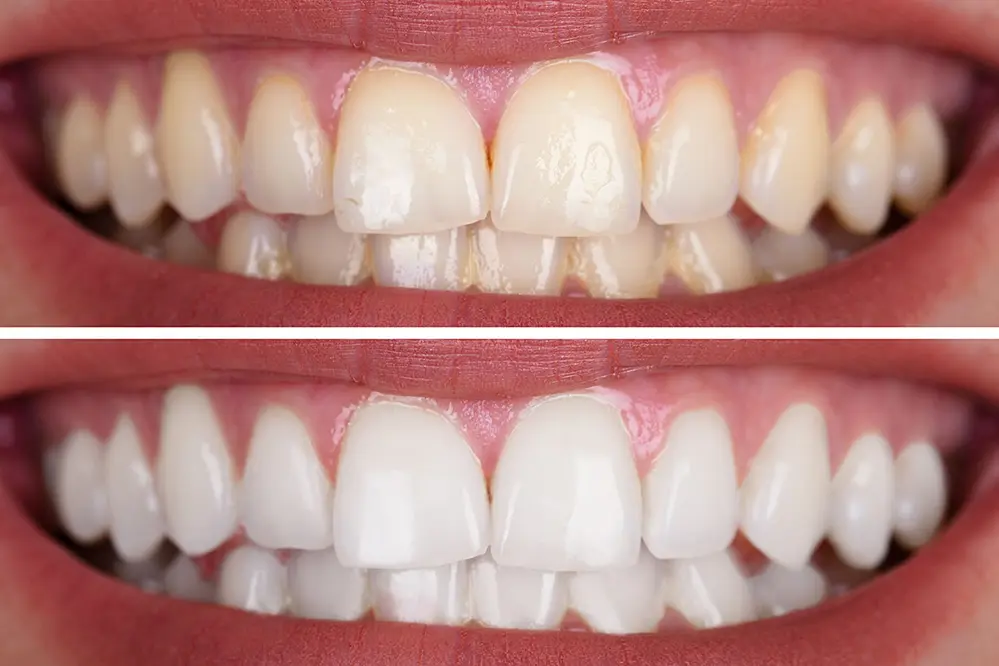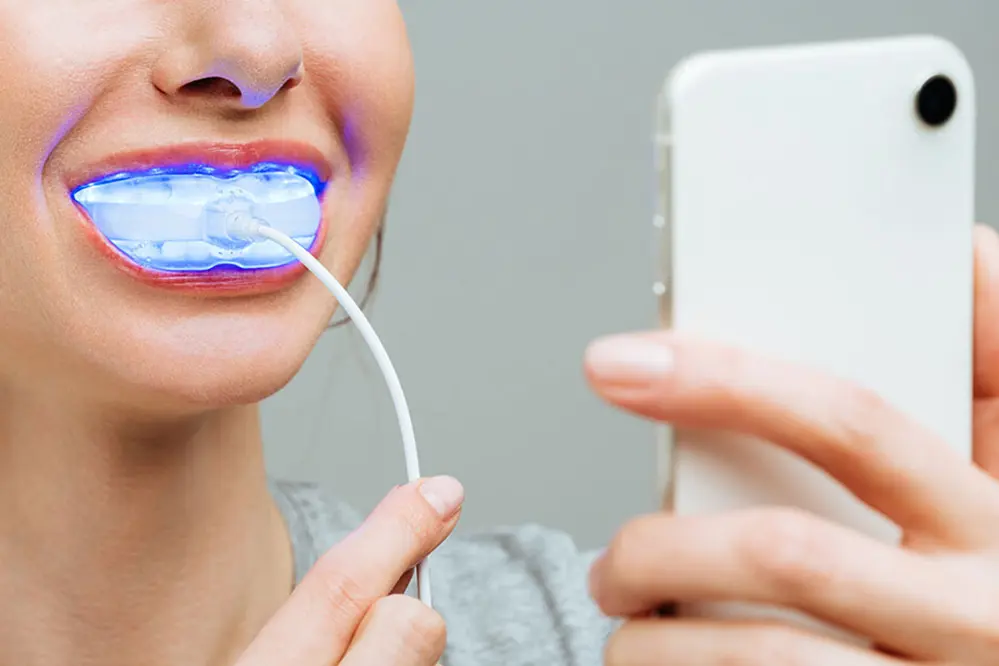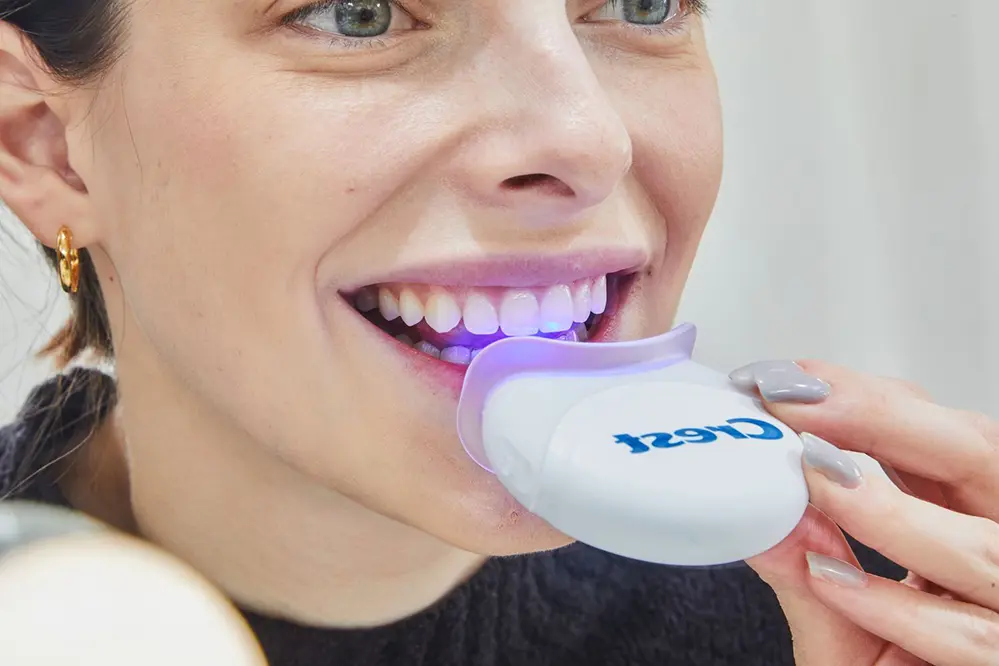Are you curious to know if LED light can truly whiten teeth? Look no further! In this blog post, we will delve into the science behind photoactivated processes and explore the efficacy of using LED technology for teeth whitening.
LED light has the potential to influence peroxide-based reactions commonly used in teeth whitening protocols. By engaging specific wavelengths, LED technology can catalyze the whitening process. However, the effectiveness of this method is a subject of scrutiny and requires a closer examination.
Join us as we uncover the truth behind LED light and its impact on teeth whitening. We will explore the scientific evidence, discuss the pros and cons, and provide you with a comprehensive understanding of this innovative approach. Let’s dive in!
The Science Behind LED Teeth Whitening

The underlying principle of LED teeth whitening resides in photopolymerization, a process where light energy, including that of the UV light, acts as a catalyst to accelerate the bleaching action of peroxide compounds embedded within whitening agents. When the appropriate wavelength of LED light strikes the peroxide molecules, it generates reactive oxygen species (ROS), which are the primary agents responsible for breaking down the chromogenic bonds that contribute to dental discoloration. This oxidation process effectively lightens the pigmentation of tooth enamel, leading to the brightening effect sought in teeth whitening treatments. It is the precise control of LED’s light intensity and wavelength that makes this an innovative and increasingly popular approach in cosmetic dentistry.
How LED Technology Affects Teeth
Under the illumination of LED light, peroxide initiators in whitening agents get activated, enhancing the whitening effect with remarkable speed and efficiency. This process is termed as photoactivation.
Prolonged or improper exposure, however, can lead to “rebound pigmentation.” Excessive light may overheat enamel, causing it to revert to a darker shade, compromising the whitening outcome.
LED accelerates peroxide breakdown without raising the tooth’s internal temperature to damaging levels.
Optimal usage requires precision: precisely measured light intensity and wavelength target the peroxide agents to break down stains while preserving tooth enamel integrity. LED technology thus stands at the vanguard of aesthetic dentistry, combining efficiency with safety.
The Role of Whitening Agents
Whitening agents are crucial in the process of removing discoloration from teeth. They often contain peroxides, such as hydrogen peroxide or carbamide peroxide, which serve as the active ingredients.
When applied to the teeth, these peroxides interact with the chromogens—the compounds responsible for staining. The chemical reaction breaks down the stain molecules, leading to a lighter appearance of the teeth.
However, it’s not merely the presence of these peroxides that ensures success; the activation and regulation of these compounds are vital. This is where LED light can play a pivotal role, enhancing the agent’s efficacy without compromising safety.
During the whitening process, the applied agents adhere to the tooth’s surface and penetrate the enamel. The LED fosters a catalyst-like effect, accelerating the reaction that dismantles the stains.
Without a doubt, the whitening agents carry the primary responsibility for bleaching the teeth, but their performance is significantly amplified by the correct application of LED light.
Comparing LED to Other Whitening Methods
LED teeth whitening has burgeoned as a convenient at-home treatment, juxtaposed against traditional in-office and over-the-counter methods.
- In-office whitening procedures often employ high-concentration peroxide gels activated by specialized UV or laser lights, providing dramatic results in a short period.
- Custom-fit tray-based systems, used at home, involve lower peroxide concentrations over extended periods, typically yielding gradual whitening over weeks.
- Over-the-counter strips and paint-on products present an accessible and affordable option, though they may be less potent and thus deliver subtler outcomes.
- Whitening toothpastes and mouthwashes aim to remove surface stains through gentle abrasion and chemical interaction but are usually less effective than peroxide-based treatments.
LED-based systems straddle the divide, offering accelerated results akin to in-office treatments.
LED options tend to produce visible results more rapidly than tray-based and over-the-counter strategies, albeit typically less intense than professional in-office procedures.
Benefits of LED Whitening

The utilization of LED technology in teeth whitening harnesses specific wavelengths of light that accelerate the bleaching process initiated by peroxide-based gels. This methodology facilitates a hastened breakdown of stains on the enamel, enabling the whitening agents to act more efficiently and effectively. Crucially, LEDs produce minimal heat compared to UV or laser counterparts, reducing the risk of tooth sensitivity post-treatment. Additionally, LED whitening systems are designed to be safe for at-home use, offering consumers a convenient and cost-effective route to achieve dental-grade aesthetic results. Their growing popularity is attributable to the balance they strike between expedience, efficacy, and safety.
Speed and Efficiency
In the realm of teeth whitening, speed translates to less time with treatment adhered to the enamel—a desirable factor for many users.
With LED teeth whitening, time efficiency is a primary allure. Once the peroxide-based gel is applied to the teeth, the LED light acts as a catalyst, expediting the breakdown of stains that contribute to discoloration. This process enables whitening agents to penetrate the enamel rapidly, delivering noticeable results within a shorter time frame compared to other at-home methods. This accelerated action allows for quick transformation, often visible after just a few applications.
Improvements can often be discerned after a single session, a testament to the technology’s proficiency. Regular LED whitening sessions, typically lasting no more than thirty minutes, can effectively maintain the whiteness of teeth over time. The speed at which these results are achieved is a significant advantage for those seeking prompt enhancements to their dental aesthetics without extensive disruption to their daily routine.
Furthermore, such swift achievements do not come at the cost of safety. When used in accordance with manufacturer guidelines, LED teeth whitening can deliver these rapid results without the higher risks associated with more aggressive dental procedures. In-clinic options, albeit faster, often involve stronger bleaching agents that can lead to increased tooth sensitivity and other complications. Thus, LED teeth whitening occupies a unique position, offering both an expeditious and gentle route to a brighter smile, solidifying its reputation among consumers who prioritize both speed and dental well-being.
Safety Considerations
The efficacy of LED teeth whitening is not without safety concerns. When considering this method, the spectral output of the LED light must be evaluated for potential hazards to oral tissues.
The intensity and duration of exposure to LED light are pivotal factors in ensuring patient safety. Manufacturers have an onus to establish clear usage protocols that safeguard against gum irritation and tooth enamel damage. Noncompliance with these protocols might increase the risk of adverse effects.
Moreover, the concentration of whitening agents used in tandem with LED lights necessitates caution. High-concentration peroxides, if improperly managed, pose a risk of chemical burns to the oral soft tissues. This, paired with the need for adequate protective measures during treatment, is crucial for preventing harm.
Similarly, patient-specific considerations, such as pre-existing dental conditions or sensitivities, need to be meticulously assessed. Dental professionals must tailor treatments to individual profiles to obviate complications arising from the one-size-fits-all approach to LED whitening.
In summary, while LED teeth whitening can be a safe practice, stringent adherence to safety protocols is indispensable. Dental practitioners must exercise diligent oversight to preserve and protect oral health during whitening procedures.
Longevity of Whitening Effects
The duration of teeth whitening effects is not uniform, depending on several variables.
- Lifestyle choices: such as smoking and consuming staining substances like coffee, tea, and red wine
- Oral hygiene practices: including regular brushing and dental checkups
- Type of whitening agent used: as some may produce longer-lasting results
- Individual tooth structure: which can affect how well the whitening results are retained
- Follow-up maintenance: which is critical to prolong the effects of whitening
Teeth whitening with LED light typically offers temporary improvements, according to many dentists.
Staining agents and individual dental health will ultimately dictate the enduring nature of teeth whitening.
Real Results: What to Expect

Patients seeking LED teeth whitening should consult with their dentist to manage expectations, as results can vary significantly. While some individuals experience a noteworthy enhancement in tooth brightness, others may observe subtler changes. The initial shade of the teeth and the concentration of the whitening gel play significant roles in determining the outcome. It’s essential to understand that, despite advances in LED technology, the whitening process is not a one-size-fits-all solution, and efficacy can differ from person to person. Moreover, even with rigorous application of LED light therapy, the intrinsic qualities of an individual’s teeth may limit the potential degree of whitening achievable.
Professional vs. At-Home LED Kits
LED teeth whitening can vary in effectiveness based on professional application versus at-home kits.
- Efficacy: Professional treatments typically use stronger bleaching agents coupled with high-intensity LED lights for optimal results.
- Safety: Dentists can ensure proper gum protection and monitor for adverse reactions, which might be overlooked with at-home kits.
- Cost: In-office procedures are more expensive than purchasing an at-home LED kit.
- Convenience: At-home kits offer the flexibility to conduct treatments on one’s own schedule.
- Regulation: Professional treatments are administered by licensed professionals, ensuring adherence to health and safety standards.
- Customization: Dentists offer tailored solutions and can adjust concentrations for sensitive teeth, something that at-home kits lack.
In-office treatments by a dental professional offer the safest and most potent form of LED teeth whitening.
For those seeking a more budget-friendly and convenient option, at-home LED kits may suffice, though with potentially less dramatic results.
Factors Influencing Whitening Outcomes
The duration and frequency of LED light exposure significantly impact the whitening effectiveness of treatments. Insufficient application may yield suboptimal results, while overuse could potentially harm tooth enamel or cause sensitivity.
Concentration levels of whitening agents play a vital role in the outcome of LED teeth whitening. Higher concentrations can offer quicker and more pronounced whitening effects but may also increase the risk for tooth sensitivity or gum irritation.
The initial shade and condition of a person’s teeth set the baseline for potential whitening success. Individuals with yellowish hues tend to see more drastic improvements than those with grayish or brownish discoloration due to intrinsic staining factors.
Patient adherence to post-whitening care instructions is critical to the maintenance of whitening results. Practices such as avoiding staining substances and adherence to oral hygiene can prolong the effects, while neglect can cause rapid re-staining.
The technological sophistication and quality of the LED light used can also influence whitening results. Substandard LEDs may not provide appropriate wavelength or intensity, rendering the treatment less effective or even inconsistent.
Managing Expectations
When contemplating LED teeth whitening, setting realistic expectations is paramount to satisfaction.
- Pre-treatment assessment is crucial for understanding individual whitening potential.
- Whitening isn’t uniform, as variance in tooth composition affects outcome.
- Maintenance routines post-treatment will dictate the longevity of results.
- Understand that not all LEDs are equal—opt for professional-grade equipment.
- Patience is key; multiple sessions may be needed for desired whitening.
Success with LED light-induced teeth whitening is not a guarantee.
A professional consultation will help temper expectations with expertise and tailored advice.
Potential Risks and Precautions
When considering LED teeth whitening, potential risks include gum irritation, increased tooth sensitivity, and in extreme cases, damage to tooth enamel. The application of high-intensity light necessitates precision and protective measures to safeguard oral tissues.
Individuals should consult with dental professionals before engaging with LED whitening systems. A thorough evaluation can help minimize complications and ensure the compatibility of the treatment with one’s dental health.
Recognizing Common Side Effects
Mild tooth sensitivity is a frequently observed side effect following LED teeth whitening treatments. It is typically temporary and subsides with time.
Some patients may experience minor gum irritation or inflammation.
In certain cases, individuals report an uneven whitening effect, which is most noticeable when the light has not been applied uniformly across the teeth surfaces. This could result in splotchy or striped appearance which might be aesthetically displeasing.
More serious, albeit less common, side effects include prolonged tooth sensitivity and gum irritation that persists beyond the initial post-treatment phase. These symptoms may indicate overexposure to the LED light or an underlying vulnerability of the oral tissues. In such instances, seeking professional advice is imperative to address any potential complications and to receive guidance on proper aftercare protocols.
When to Avoid LED Whitening
Individuals with pre-existing dental conditions should be particularly cautious, as LED whitening could exacerbate sensitivity or damage weakened enamel.
Those with restorations such as veneers or crowns may find uneven results post-whitening.
Pregnant or nursing individuals should abstain from LED whitening due to the lack of research on the effect of whitening agents during these periods.
Children and adolescents should also avoid LED whitening treatments, since their enamel is still developing and more susceptible to harm.
Patients with a history of photoreactivity or light-induced disorders should avoid LED whitening to prevent triggering any photosensitive reactions that could affect their oral or general wellbeing.
Finally, those with dental braces should wait until their orthodontic treatment is complete. LED whitening can lead to uneven coloration due to the areas covered by brackets.
Best Practices for Safe Usage
Ensure proper evaluation by a dental professional before engaging in any form of LED teeth whitening.
To minimize risks, follow manufacturer’s instructions meticulously, including the suggested duration and frequency of use for the LED device.
Utilize LED whitening in conjunction with a protective gel or barrier specifically formulated to shield gums and oral soft tissues from any potential irritants or thermal effects.
Monitor for adverse reactions continuously during the whitening process, and be prepared to halt treatment if any discomfort or sensitivity arises.
Finally, maintain regular dental check-ups to assess the long-term impact of LED teeth whitening on dental health.
Conclusion
In light of all considerations, LED teeth whitening presents as a viable option for those seeking cosmetic dental improvements. However, its effectiveness can vary significantly between individuals, influenced by factors such as initial tooth color and the presence of restorations or intrinsic stains.
When following established guidelines, LED whitening can be an effective part of a broader oral care regimen. It is crucial, however, to pair this technology with professional oversight.
While the quest for a brighter smile can be enticing, the responsibility falls on practitioners and users alike to approach teeth whitening with prudence. Providers of LED whitening systems must prioritize patient education, ensuring that the limits and potential risks of the treatment are well-understood.
Above all, the role of comprehensive oral hygiene cannot be overstated. While LED whitening may offer aesthetic benefits, it must be viewed as a supplement, not a substitute, for routine dental care and good oral health practices. Only through such a balanced and informed approach can one expect to achieve and maintain the radiant smile they desire, without compromising dental integrity.





